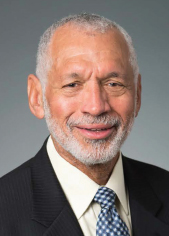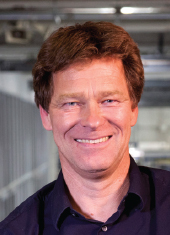Appendix B
Panelists’ Biographies

The Honorable CHARLES F. BOLDEN JR. was NASA administrator from 2009 to 2017, overseeing the transition from the Space Shuttle system to a new era of exploration focused on the International Space Station (ISS) and aeronautics technology development. He is now president and CEO of the Bolden Consulting Group LLC.
During his 34-year career with the Marine Corps he worked in NASA’s Astronaut Office and traveled into orbit four times, logging over 680 hours in space. He piloted the Space Shuttles Columbia in 1986 (STS-61C) and, in 1990, Discovery (STS-31), the mission that deployed the Hubble Space Telescope, and he was mission commander on Space Shuttles Atlantis in 1992 (STS-45) and Discovery in 1994 (STS-60). He also served as chief of NASA’s Safety Division in the wake of the 1986 Space Shuttle Challenger disaster. He retired from the Marine Corps in 2004 as a major general.
As NASA administrator, Maj. Gen. Bolden oversaw the shift toward commercial space initiatives handling ISS resupply and created the Space Technology Mission Directorate, responsible for developing the technology to make future exploration missions successful. His tenure included the triumph of the Mars Curiosity Rover landing, the success of the Juno mission that is enhancing knowledge of the planet Jupiter, an increase in the number of Earth observation satellites, and progress toward the expected 2020 launch of the James Webb Space Telescope.
He was a US Department of State Science Envoy for Space (2018–19) and is an independent director of the LORD Corporation, Atlas Air Worldwide Holdings, and Blue Cross Blue Shield of South Carolina.
Maj. Gen. Bolden earned his BS in electrical science from the US Naval Academy and MS in systems management from the University of Southern California.

ROBERT L. CRIPPEN was the pilot of the first Space Shuttle flight in April 1981 and went on to command three other Space Shuttle missions. He has logged more than 565 hours in space and orbited the earth 374 times.
During his 30 years in the US Navy, he was an attack pilot aboard the USS Independence and then a test pilot instructor at Edwards Air Force Base in California. In 1969 he was selected as a NASA astronaut and was on the support crew for the Skylab 2, 3, and 4 missions and the Apollo-Soyuz Test Project.
Captain Crippen became director of the Space Shuttle program at NASA Headquarters in Washington and then director of the Kennedy Space Center in Florida. He entered the private sector as a vice president at Lockheed Martin in Orlando and then served as president of the Thiokol Propulsion Company in Brigham City, Utah.
His numerous awards include the Distinguished Flying Cross from the US Navy, Defense Superior Service Medal, Federal Aviation Administration Award for Distinguished Service, Goddard Memorial Trophy, National Geographic Society Hubbard Medal, American Legion Distinguished Service Medal, Congressional Medal of Honor for Space, and Leadership and Service Medals from NASA. He has been inducted into the Astronaut Hall of Fame, Aerospace Walk of Fame, and National Aviation Hall of Fame in 2016. He is a fellow in the Society of Experimental Test Pilots and an honorary fellow in the American Institute of Aeronautics and Astronautics. He was elected to the NAE in 2012.
Captain Crippen earned his BS in aerospace engineering from the University of Texas at Austin.

As Boeing’s first commercial test pilot astronaut, CHRISTOPHER J. FERGUSON will be among the first to fly to space aboard the CST-100 Starliner. He has led the development of the spacecraft’s mission systems and crew interfaces.
Since 2011 he has worked with NASA’s Human Exploration and Operations Directorate; Johnson Space Center’s Engineering, Flight Crew, and Mission Operations organizations; and NASA’s Commercial Crew Program at Kennedy Space Center to ensure that Boeing’s design supports NASA’s human rating requirements. He was also a leader in the development and testing of system concepts and technologies for the spacecraft’s launch and ground systems.
A retired US Navy captain and former NASA astronaut, he piloted STS-115 (Atlantis) and commanded STS-126 (Endeavour) and the final shuttle mission, STS-135 (Atlantis), logging more than 40 days in space and 5,700 hours in high-performance aircraft. Capt. Ferguson also served as deputy chief of the NASA Astronaut Office and as spacecraft communicator for the STS-118, STS-120, STS-128, and STS-129 missions.
His service has been recognized with the Legion of Merit, Distinguished Flying Cross, Defense Meritorious Service Medal, Navy Strike/Flight Air Medal, NASA Spaceflight Medal (three), Navy Commendation Medal (three), and Navy Achievement Medal.
Capt. Ferguson holds a BS in mechanical engineering from Drexel University and an MS in aeronautical engineering from the Naval Postgraduate School.

HANS KOENIGSMANN, vice president of the Build and Flight Reliability Team at SpaceX, leads the company’s quality engineering and process development teams; oversees the launch readiness process during launch campaigns; and assesses launch risks, identifying and resolving anomalies during integration and launch.
He has more than 25 years of experience designing, developing, and building complex avionics and guidance, navigation, and control
(GNC) systems for launch vehicles and satellites. At SpaceX since the company’s inception in 2002, he has built up the avionics, software, and GNC departments and developed the launch readiness process used during each launch campaign. He designed the company’s risk mitigation process and initiated the risk database, establishing a similar process for system-level changes to the vehicle and ground systems. He was the chief avionics architect of the Falcon 1 and early Falcon 9 efforts, and launch chief engineer for the last three Falcon 1 missions and most of the Falcon 9 flights.
His experience includes the development of two suborbital and two orbital launchers as well as several satellite projects and attitude control systems. He headed the Space Technology Division of Germany’s Center of Applied Space Technology and Microgravity (ZARM) at the University of Bremen, where he was responsible for the development and operation of the satellite BREM-SAT. He then worked for Microcosm as chief scientist and flight systems manager for their suborbital vehicles.
Dr. Koenigsmann has an MS in aerospace engineering from the Technical University of Berlin and a PhD in aerospace engineering and production from the University of Bremen.

SANDRA H. MAGNUS is principal of AstroPlanetview, LLC and former executive director of the American Institute of Aeronautics and Astronautics (AIAA).
Selected to the NASA Astronaut Corps in 1996, Dr. Magnus flew in space on the STS-112 shuttle mission in 2002 and on the final shuttle flight, STS-135, in 2011. She also flew to the International Space Station on STS-126 in 2008, served as flight engineer and science officer on Expedition 18, and returned home on STS-119 after 4½ months on board. She then served at NASA Headquarters in the Exploration Systems Mission Directorate. Her last duty at NASA, after STS-135, was as deputy chief of the Astronaut Office.
At NASA Dr. Magnus worked extensively with the international community, including the European Space Agency (ESA) and Japan Aerospace Exploration Agency (JAXA) as well as Brazil on facility-type payloads. She also spent time in Russia developing and integrating operational products and procedures for the ISS.
She was previously a stealth engineer at McDonnell Douglas Aircraft Company (1986–91), working on internal research and development and on the Navy’s A-12 Attack Aircraft program, studying the effectiveness of radar signature reduction techniques.
Her service has been recognized with the NASA Space Flight Medal, NASA Distinguished Service Medal, NASA Exceptional Service Medal, and the 40 at 40 Award (given to former collegiate women athletes to recognize the impact of Title IX).
Dr. Magnus earned her BS in physics and MS in electrical engineering from the Missouri University of Science and Technology, and her PhD from the School of Materials Science and Engineering at Georgia Tech.

US Air Force Lieutenant General (ret.) and former NASA astronaut THOMAS P. STAFFORD has logged nearly 521 hours in space, flying six rendezvous on four types of spacecraft. In 1965 he piloted Gemini VI, the first rendezvous in space, and in 1966, commanding Gemini IX, he demonstrated a rendezvous used in the Apollo lunar missions. He headed the mission planning analysis and software development for Project Apollo, and as commander of Apollo 10 in 1969 he flew the first rendezvous around the moon and designated the first lunar landing site. He was cited in the Guinness Book of World Records for the highest speed ever attained by a human, when Apollo 10 attained 27621.7 statute mph or Mach 36 during reentry. In 1975 he was commander of the Apollo-Soyuz Test Project mission, which culminated in the historic first meeting in space between US astronauts and Soviet cosmonauts, ending the international space race.
As Commanding General at Edwards AFB he presided over the development of the B-1A, F-15, YF-16, A-10, YC-14, and YC-15, and as US Air Force Deputy Chief of Staff for Research, Development, and Acquisitions he conceived of and started the stealth aircraft programs the F-117A, B-2A, AGM-129, and the roadmap for the F-22 Raptor. He retired from the Air Force in 1979 and in 1982 cofounded the technical consulting firm of Stafford, Burke, and Hecker in Alexandria, VA.
In 1990 in response to a request from Vice President Dan Quayle and Admiral Richard Truly, then NASA administrator, General Stafford assembled teams from the DOD, DOE, and NASA to prepare “America
at the Threshold,” a roadmap for the next 30 years of the US Manned Space Flight Program beyond low Earth orbit.
He chaired the Operations Oversight Committee of the first Hubble Telescope Spacecraft Servicing and Repair Mission that corrected the instrument’s design and manufacturing defect, for which he received the NASA Public Service Award (1994), and also chaired the Shuttle Return to Flight Group to carry out the recommendations of the Spaceship Columbia Accident Board. He has received numerous other honors and medals from NASA and the Air Force, as well as the Congressional Space Medal of Honor, Wright Brothers Memorial Trophy, and AIAA Chanute Flight Award, to name just a few. In addition to his NAE membership, he is a fellow of the American Astronautical Society, American Institute of Aeronautics and Astronautics (AIAA), and Society of Experimental Test Pilots, and has been inducted into the Astronaut Hall of Fame and National Aviation Hall of Fame.
General Stafford received his BS with honors, in electrical and mechanical engineering, from the US Naval Academy and graduated 1st in class at the USAF Test Pilot School in 1959.

DEANNE BELL is an engineer, television host, and entrepreneur. Her television hosting credits include PBS, ESPN, Discovery Channel, National Geographic, DIY Network, and most recently CNBC’s Make Me a Millionaire Inventor. She is also the founder and CEO of Future Engineers, an education technology company that engages students in online contests and challenges. Future Engineers’ inaugural competition, developed with the ASME Foundation and NASA, produced historic achievements including the first student-designed 3D print in space. Her company has since become a US Department of Education SBIR awardee, and was selected by NASA to host the Mars 2020 “Name the Rover” contest.
Previously she worked at Raytheon for three years as an optomechanical engineer. She focused on packaging FLIR into a helicopter-mounted gimbal, involving the redesign of the afocal telescope and the packaging of the cryo-cooled imager and CCD camera. She then worked for other R&D programs at the company, including as head of the mechanical design and build of a synthetic aperture ladar (SALTI) optical test bench.
She earned her BS in mechanical engineering at Washington University in St. Louis and was selected by its McKelvey School of Engineering to receive the Young Alumni Award in 2019.







